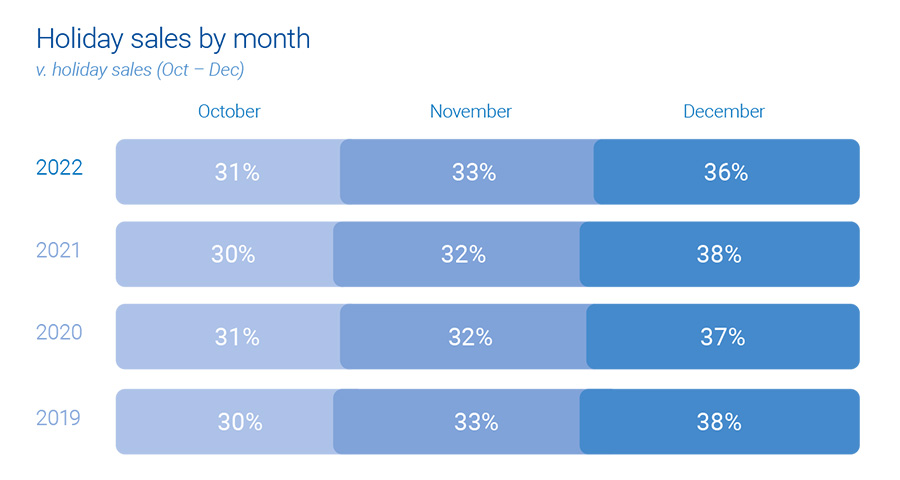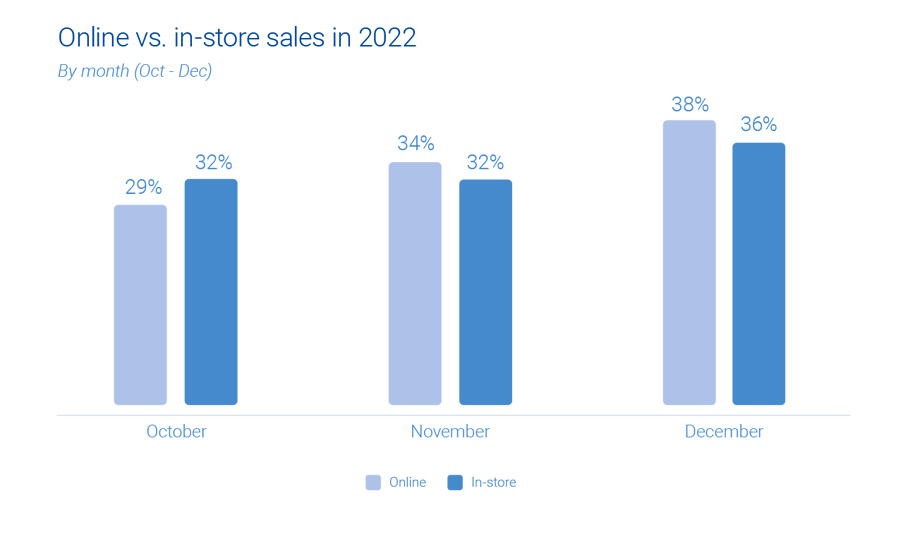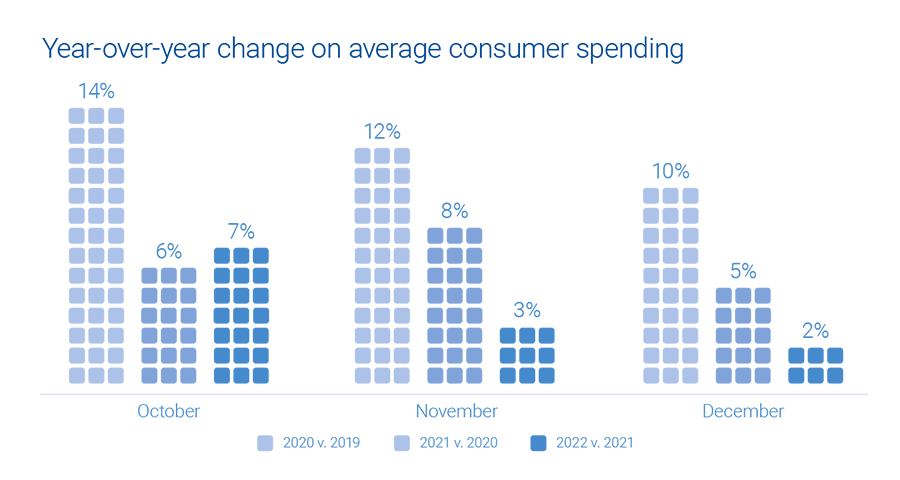
The holiday season is just around the corner, and retailers and marketers are gearing up for the busiest shopping period of the year. It’s crucial to understand how consumer behavior is evolving and what emerging trends to expect. Experian’s 2023 Holiday spending trends and insights report analyzes recent trends, consumer spending habits, and anticipates what’s to come in 2023 to help you deliver a top-notch shopping experience this holiday season.
In this blog post, we’ll cover three key insights from our report.
1. Consumers are shopping earlier
It’s no secret that December has always been the go-to month for consumers when it comes to holiday spending. However, holiday shopping now starts earlier, particularly with online sales.

This can be attributed to a surge in promotions and deals, enticing shoppers to open their wallets ahead of time, giving a significant boost to holiday sales. Notably, Cyber Week sales have proven to be an influential factor, accounting for 8% of total consumer holiday spending.
Experian tip
Reach the right shoppers with your promotions with sell-side targeting. This powerful approach gives you control over where your ads are placed while ensuring maximum visibility through direct connections with publishers. Whether on mobile, web, or CTV, this seamless ad experience will engage your audience effectively.
2. Online sales are on the rise
The popularity of online holiday sales is continuously growing, surpassing in-store shopping. There has been a consistent 1% year-over-year increase in online sales, while in-store sales have seen a 1% decrease.
“It’s easier for consumers to comparison shop for large ticket items online that they might find at a mass retailer or office supply store. Consumers prefer to have larger, bulkier items shipped directly to their home for minimal cost. By shopping online, consumers can save time since they don’t need to wait in checkout lines.”
Anna Liparoto, Sr. Account Executive, Retail & CPG

Although online sales currently make up only one-third of all holiday shopping, there is immense potential for further expansion. Mass retailers and office, electronics, and games industries particularly excel in online holiday sales. While in-store purchases remain the primary choice for holiday shoppers, consumer online and offline activities intersect before the final purchase.
Experian tip
Take advantage of the surge in online shopping by diversifying your marketing channels. An agnostic identity graph can bring together device and media data, capturing valuable user insights. By gaining a holistic view of your target audience, you’ll be able to optimize your ad spend and allocate resources effectively, ultimately boosting your return on investment.
“Omnichannel targeting during the upcoming holiday season will continue to prove to be the best way to reach scale and maximize ROI across all marketing channels.”
Joe LigÉ, Head of Enterprise Demand Partnerships
3. 2023 holiday spending will be on par with 2022
During the holiday season in 2022, consumer spending showed an anticipated increase, although the growth rate was slightly lower compared to previous years. October saw a surge in average consumer spending, indicating a swift response to early discounts and promotions offered by retailers.

As the holiday season progressed, holiday spending gradually slowed down and reached a level similar to that of the previous year. Overall, there was a modest 2% growth. Looking into the future, if economic conditions remain stable in the second half of 2023, we can expect holiday spending to align with the figures from last year.
Experian tip
To truly maximize impact, consider data enrichment. By diving deeper into your target audience’s preferences and behaviors, you can better tailor your strategies and seamlessly integrate the enriched data across various channels. This allows you to unlock the true potential of your ad inventory, creating more meaningful connections with your audience.
Download our 2024 report
Get ready for the holiday shopping season with Experian’s 2024 Holiday spending trends and insights report. Inside you’ll find:
- Analysis of past trends and what they mean for 2024
- Exclusive predictions for the upcoming holiday season
- The top audiences to activate this holiday season
To access to all of our predictions for this year’s holiday shopping season, download our 2024 Holiday spending trends and insights report today.
Latest posts

It’s been more than two months since COVID-19 was declared a national emergency on March 13 and since that time, consumers have dealt with a lot of uncertainty and fear—ranging from the health and safety of their families to financial stability and beyond. With the prospects of returning to normal changing every day, consumers’ feelings around the pandemic and how they’ve adjusted have also shifted and will continue to do so in the months ahead. But just as the situation has been unprecedented for consumers, businesses are also in uncharted territory. Many have had to adapt operational strategies, while maintaining their ability to service their customers. Now, with stay-at-home orders beginning to lift and the easing of business restrictions in most states across the country, organizations will need to listen to their customers to help inform strategy moving forward, including reopening and operating in a post-pandemic environment. To help, we instituted a survey of the general population to better assess how consumer sentiment is shifting during the pandemic. In the five weeks since the data was made available on April 1, we’ve identified trends across a number of key areas of interest. General observations Less than a third of Americans (29%) are satisfied with their current situation; which has been fairly consistent throughout the five weeks.Women appear to have been quicker to grasp the seriousness of COVID-19 and feel the impact of the pandemic on their livelihood. Overall sentiment among women has improved but still remains lower than men. Americans experiencing minimal impact tend to be:Millennial males, residing in western urban areas who rent.Those less likely to watch the media and spend more time on entertainment.Only 10% of Americans are still willing to take on risk—buying investments and assets. Millennials tend to be more optimistic and actively taking on debt, seeking financial advice, buying assets/investments, considering new vehicle purchases. Retail spending heavily impacted 43% of consumers are cutting back on overall retail spend.Groceries and entertainment are the only categories that have experienced increases in retail spending compared to the past month throughout the five-week period. Spending on discretionary purchases like clothing, shoes, accessories, beauty and wellness has been significantly down for the past month.Baby Boomers and to a lesser extent, Generation X have been cutting back spending everywhere except groceries, but Generation Z respondents increased spending in most categories compared to the past month in the most categories. Americans experiencing financial hardship Half of American households are experiencing financial hardship; though the percentage has improved slightly from the beginning of April. Of those experiencing financial hardship, 74% have concerns about their ability to access food and essentials in the next month.More Americans have a financial reserve they can draw on than a month ago, suggesting consumers are adjusting and reducing their risk. The percentage of Americans who believe their situation will get better in the next month or so has increased. Feelings about healthcare remain consistent 62% of respondents are concerned about visiting the doctor, and 37% are evaluating alternative care methods. Health concerns remain prevalent, but Americans are a little less concerned about filling prescriptions than a month ago. A little more than half of Americans are confident of their ability to pay medical expenses if a family member contracts COVID-19 and requires hospitalization—a small improvement since the survey began (46%). Increased media consumption 58% of respondents are spending more time on home entertainment, including streaming services, social media and video games.The survey shows Netflix has benefitted the most from increased TV/movie consumption; but other services have experienced strong gains. Nearly one-third of Americans have increased their video game play during the COVID-19 pandemic; though the percentage is down from its peak in mid-April.Baby Boomers are more likely to have increased their viewing of Cable TV, but much less likely to have increased consumption of any other media sources.Generation Z and Millennials are increasing consumption of a broader array of media, including Instagram, YouTube, video games, Snapchat, Spotify and Tik Tok. How do businesses move forward? Using insights to inform strategy With much of the focus for politicians, local community leaders and health experts shifting to reopening businesses and public establishments, we have to keep in mind, the post-pandemic environment will look much different than what it was just a few months ago. Just because businesses get the green light to open, there may be hurdles to return to “business as usual.” Consumers’ appetite to resume normal engagement with businesses will vary. For instance, some may opt for curbside pickup or delivery options for retail purchases or telehealth services for routine medical needs. Businesses need to adapt to the customer. In an ecosystem driven the customer experience and human connection, gauging consumer sentiment and preference will be a crucial first step. The road ahead will be long, but the more businesses understand their customers, the better positioned they will be to deliver effective communications and also make strategic investments. What programs and initiatives can be started to better serve customers? What areas can be cut to save costs? Our world was turned upside down the last two months and continues to change every day with still many unknowns. As businesses plan for the next few months and beyond, it’ll be critical to understand how consumer mindsets and behaviors are shifting. Relevancy has always been mission critical, but now, more than ever, businesses need to have consumers at the center of their strategies.

Marketers are always looking for creative ways to get the most out of their digital marketing investments. While there may be different paths to optimization, reducing media spend and cutting costs without sacrificing ROI is ideal. We empower marketers to take back control of their budgets and reinvent their media strategies by leveraging the right data at the right time. And, given today’s challenging climate, there’s no better time. Every Business Has Different Deeds Whether you’re a direct-to-consumer brand building a loyal customer base or a financial service simply letting customers know you’re here for them during a challenging time– identity resolution is essential to connecting with your audience without breaking the bank. That’s why we have built solutions that provide flexibility and control when you need it most. Putting Data Into Action Experian's "Tapad Graph" is a global, privacy-safe cross device graph is one powerful file. Updated weekly, and containing customized device IDs and digital attributes, The Tapad Graph enables smarter targeting strategies and a reduction of wasted impressions. What that means is more marketing efficiency and a stronger ROI for your business. Saving resources and money sound good to you? This guide breaks down four ways you can implement cost savings measures without sacrificing performance or prohibiting KPIs. Frequency Capping and Suppression Clustering device IDs by the individual and household means you have access to more ways to reach consumers, but it doesn’t always mean you should be using all of them across every campaign. Hone in on the channels and devices where consumers make most of their lower funnel decisions and purchases – and cap brand-awareness level placements or aspirational media that requires more exposure to generate engagement. This doesn’t mean limiting the devices you target, but being more aware of how often you’re targeting the same person across those devices. If you’ve successfully begun, or heck, even completed the consumer journey with an individual, congratulations. Now, you may want to consider what to do with the rest of the digital devices and users in that same household. Sure, there’s a time for conquesting an entire home of purchasers, but that’s not always the most effective way to maximize your media. That’s why The Tapad Graph is built to be flexible, providing a holistic view of all individuals and their associated devices and digital IDs – so you can suppress them once you’ve conquested the household decision maker or achieved the desired lower funnel activity. Save those impressions for someone else and save money for yourself. The great thing is whether you’re uploading this data into a DMP or a DSP, you can segment your target audience with a frequency cap threshold or suppress them entirely. Not only can you apply these tactics across traditional digital media, but we can include Connected TVs for OTT targeting as well, making your media strategy as holistic as your identity resolution tactics. Cross-Device Targeting and Attribution Consumer behavior and device trends are changing these days, so shouldn’t your digital marketing change too? Desktop usage is now up as much as 22%* as more people are working and learning from home. And remember that old iPad? With more people at home, we’re dusting off more devices and tablet activity is increasing more than 30%*. Sure, people are still constantly on mobile– but it might be time to consider implementing cross-device targeting and optimization for those dayparts when their focus is elsewhere. Identity resolution should be a key element of customer journey mapping and attribution in order to truly give credit to the right channels and build a baseline for the right cost-per modelling. Coupling The Tapad Graph with raw events data can granularly attribute engagement, actions and conversions at the digital ID, device, and even user-level – thereby teaching you more about your customer’s preferences. Leverage these insights to create more tailored messaging and promotions on your owned and operated channels, to funnel impressions to specific screens and platforms, and to target users based on where they are in the purchase funnel. Data That Gives You Control If you’re already implementing cross-device, have you started suppressing the devices where engagement with your brand isn’t happening? That’s right, you can use The Tapad Graph after-the-fact as well. Weekly graph updates with 60-day look-backs enable weekly campaign optimizations. That gives you the flexibility and control to avoid devices and platforms where users aren’t as active. You can only make decisions based on the data you have in front of you, so make sure you're partnering with the right solutions for your business. Does identity resolution sound like something you need? Contact us and we can help you get started with all that The Tapad Graph has to offer. Get started with The Tapad Graph For personalized consultation on the value and benefits of The Tapad Graph for your business, email Sales@tapad.com today!

The effect COVID-19 has had on lives around the globe is unprecedented. It’s fundamentally shifted our day-to-day routines, as well as many of our priorities. And yet, the fact remains, the situation for many Americans is still very fluid. How and when people will be impacted will vary, and how people respond to the pandemic will depend on circumstance. So, how do retailers and other businesses address their customers’ challenges and help them through this difficult time? First, you need to be empathetic. You need to understand how people are feeling in the current environment. What matters most to them? What challenges are they facing? How can you help? We surveyed the general population to provide retailers and other businesses insight into consumer sentiment during COVID-19. The survey is updated daily and highlights the shifts among different regions and generations. As of May 5, 2020: 50 percent of Americans are buying more online than in the past 42 percent of Americans are spending less or trying to cut back on spending; among those in urban regions, the percentage is 32 percent Groceries (46 percent) and books, video games and music (8 percent) are the categories that see the highest increase in spending over last month Those in Generation Z have increase spending across many categories compared to last month, including groceries; food delivery/takeout; books, video games, music; alcohol, beauty and wellness; clothing Usage of television and smartphone has increased by more than 50 percent each compared to last month As expected, the priorities for people across different regions and age demographics differ, but it’s important to note, these will continue to shift over the coming months. You need to be thoughtful with communications you deliver and understand when people will be in-market for your services. To accomplish this, many of the same ad principles apply—beginning with identity resolution. People are more than just the interactions they have with your brand. Like all of us, your customers engage multiple companies, as well as jump from device to device to consume information and research products and services. You need to deepen your understanding of customers’ needs whose lives you impact by connecting these digital touchpoints together as well as their preferred communication channels. If done correctly, you can create specific audience segments, better assess the appropriate time to reach out to your customers and connect with them through appropriate messages. With so many lives upended, it’s important for retailers and other businesses to provide communications and resources when customers need it the most. The more you can help your customers address their most pressing needs and make them feel heard, particularly during this difficult time, the stronger relationship you will build. All of our circumstances and situations are unique to us, so it’s important to communicate with our customers, be there for them and address their specific needs. Download the Understanding and Serving Consumer Needs During COVID-19 and Beyond whitepaper to find out how your organization can pivot to accommodate ever-changing consumer needs and concerns.